World Scleroderma Day’s June 29th Date Inspired By Death of Artist and SSc Patient Paul Klee

June 29th is recognised around the world as being World Scleroderma Day. This date is an opportunity for anybody with an interest in scleroderma (systemic sclerosis) to join together as a single, united global voice, to shine the spotlight on this relatively little understood rare disease.
Due to the present unwelcome reality that is currently the case for the rare disease patient, the patient often becomes the medical expert in their diagnosis and disease management.
I have blogged about why rare disease day is so important to the Ssc patient before — to read the article click here.
In addition, I have blogged about why global collaboration is so important — to read the article click here.
The actual date, June 29th, commemorates the date when the gifted Swiss-German artist, Paul Klee (1879 – 1940) died.
The Wikipedia entry for Paul Klee includes:
‘In 1933, Klee began experiencing the symptoms of what was diagnosed as scleroderma after his death. The progression of his fatal disease, which made swallowing very difficult, can be followed through the art he created in his last years. His output in 1936 was only 25 pictures. In the later 1930s, his health recovered somewhat and he was encouraged by a visit from Kandinsky and Picasso……..
Klee suffered from a wasting disease, scleroderma, toward the end of his life, enduring pain that seems to be reflected in his last works of art. One of his last paintings, Death and Fire, features a skull in the center with the German word for death, “Tod”, appearing in the face. He died in Muralto, Locarno, Switzerland, on 29 June 1940 and was buried at Schosshaldenfriedhof, Bern, Switzerland.’
To read more on this click here.
Klee’s work was, and is, still admired around the world today. It is interesting for me to read, (having been on the scleroderma fun bus for 19 years now), that his main work focus was movement and fluidity, with him writing in 1920, ‘Motion is at the root of all growth.’ And of course, his diagnosis of diffuse scleroderma would have severely impeded his personal movement, and it is this, his symptoms, which are thought to have inspired his later work, which was block based themed.
The book: Paul Klee and His Illness: Bowed but Not Broken by Suffering and Adversity Translated from the German by G. McKay; N. McKay 1st Edition is available to buy and includes a similar diagnosis nightmare as seen today, (although, a few years quicker today, thankfully):
‘It is thought that it was not until 10 years after Klee’s death that the illness was actually given the name ‘scleroderma.’ This was due to a pioneering dermatologist and venereologist, Dr Hans Suter, who had been fascinated by Paul Klee and his art which spurred him to commence research into the illness and its influence on the art of Paul Klee’s final years. It was due to Dr. Suter’s meticulous investigations that Klee’s illness could be defined as ‘diffuse systemic sclerosis . . . ’
‘In this book the author assembles his findings and describes the rare and complex disease in a clear and comprehensible way. Further, he empathetically interprets more than 90 of Klee’s late works. The point of view of a dermatologist renders a unique source of information. It provides, on one hand, new insights into everyday medical practices at the University of Bern in the 1930s, which will fascinate doctors and local historians alike. While, on the other hand, art historians and art lovers will be absorbed by the newly discovered links between Paul Klee’s work and his illness.’
For more info on the book, click here
There is currently an exhibition featuring Paul Klee’s work, click here for details:
HOW YOU CAN GET INVOLVED:
Keep up to date with the latest info in World Scleroderma Day 2016 by following:
- www.sclerodermanews.com
- www.worldsclerodermaday.org
- www.scleroderma.org
- Facebook page: Raynauds Scleroderma Awareness Global Patients
- Events: https://www.facebook.com/events/331554997178761/
There are many different ways that you can get involved. Here are a few ideas:
- Teal is seen as the scleroderma awareness colour:
- Change your social media (twitter / facebook etc) cover photo and profile photo to an awareness photo or teal theme
- Flood twitter using #scleroderma in your tweets
- Contact your local media / radio / paper to give an interview or an awareness feature
- Wear teal and post your photos on social media event pages
- Organise an awareness event where the dress code is teal only
- Take awareness leaflets to all community healthcare professionals eg. GP surgeries, pharmacies, practice nurses
- Organise an awareness raising stand in your local hospital / healthcare provider’s building
- Any other awareness events / ideas, please post in the discussion comments section on this post, or on the facebook event page
Learn more at www.sclerodermaawareness.org
WORLD SCLERODERMA DAY 2015 — A Recap:
I had the pleasure of being a presenter and part of the European co-hort who gave a presentation at the European Parliament, Brussels, in honour of World Scleroderma Day 2015.
To view the presentation, click here
I had not been abroad for over a decade prior to this trip, and my 7 week bed rest following the trip, was a harsh reminder why I had not been away for so long!!
Let’s make this the noisiest world scleroderma day so far, shining a huge teal spotlight on scleroderma, as together, united globally we will crack the Ssc code ~ living the dream, in the hope for a cure 🙂
Photo Credit For Paul Klee Stamp: rook76 / Shutterstock.com








